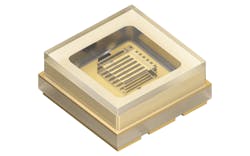Osram Opto Semiconductors has announced the Oslon UV 3636 portfolio of ultraviolet (UV) LEDs that emit at 275 nm in the UV-C band (100–280 nm) that is effective in germicidal applications. Initially the company will offer both low- and mid-power UV LEDs with high-power products planned for early 2021. Osram will target surface, air, and water disinfection applications with the new UV-C technology.
It would be easy to write Osram Opto off as yet another company trying to capitalize on the coronavirus pandemic as we have seen so many new germicidal ventures emerge across the span of light sources to disinfection systems this year. But Osram brings considerable solid-state lighting (SSL) experience to the venture. As we wrote based on a talk at Strategies in Light earlier this year, Osram Opto is the second largest manufacturer of packaged LEDs globally.
And Osram did not just find interest in UV-C in this pandemic year. The company has been involved in pan-European research projects for a number of years. In early 2017, the company joined five research institutes in the “UV Power” initiative with disinfection being one application of focus. Later that year, the company joined the Unique project focused on UV-C-based disinfection and mass market LEDs. The larger Osram operation also has long experience with legacy UV-C lamps and earlier this year said it was ramping production of UV-C lamps based on mercury-vapor technology.
The new Oslon LEDs, as the product name implies, are packaged in 3.6×3.6-mm footprint. The low-power version delivers 4.5 mW of radiometric power when driven at 30 mA. The mid-power version delivers 42 mW at 350 mA. That level of output power is not tops in the industry, but it is competitive with the technology leaders. As we covered in an article on dosage and disinfection research, the 275-nm wavelength is effective against in deactivating pathogens such as the coronavirus, although slightly shorter wavelengths can have better germicidal efficacy.
Osram also made several important points about UV-C LED technology relative to legacy sources such as lamps. The size and package technology used in the LEDs allows the source to be in direct contact with, say, water or a surface. Moreover, the relatively tight beam control enables product developments that shield the UV-C radiation from human eyes and skin for safety.
“Thanks to their compact footprint and different optical power classes, UV-C LEDs enable completely new designs and applications,” explains Christian Leirer, product manager for UV-C at Osram. “The Oslon UV 3636 is the first product in a series of innovations from Osram Opto Semiconductors in the UV-C range. A high-power UV-C LED will be launched in early 2021.”
The UV-C launch is also not Osram’s first foray outside of the human visual range. The company is a technology and market leader in the infrared (IR) band that is in longer wavelengths above the human visual range. The company has IR LEDs that specifically target applications including biometrics, night vision, security, user interfaces, and more.
For example, back in May, Osram introduced the Oslon Piccolo LEDs that are intended for integration into automotive display systems. The IR technology is used to implement gesture control. Just over a year ago, the company announced a product intended for facial recognition.
We also understand that there is more coming from Osram Opto in the near term. Indeed, more news may break later this week. Stay tuned.
For up-to-the-minute LED and SSL updates, why not follow us on Twitter? You’ll find curated content and commentary, as well as information on industry events, webcasts, and surveys on our LinkedIn Company Page and our Facebook page.







